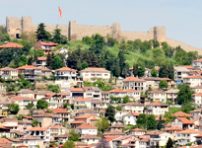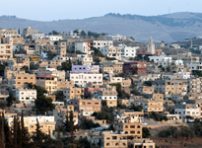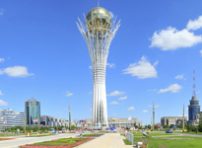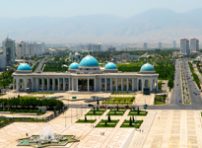About this report
Since 2006, the EBRD and the World Bank have conducted a major survey of households across the transition region – the Life in Transition survey.
Read more CloseLiTS I and II
LiTS I (2006) and LiTS II (2010) confirmed the resilience of transition – but also that it is a work in progress.
Read more Close
Foreword
The mission of the EBRD is to foster the transition towards open market-oriented economies in its countries of operations. When the Bank was created, there was little doubt about the advantage of a market over a command economy. However, as the transition to market involved economic hardship in many countries, parts of the public have become disillusioned, with reforms slowing down or even being reversed in some cases. It has become increasingly clear that transition is not sustainable unless it is perceived by the public as being fair and of benefit to the majority. This is why it is important to evaluate structural and institutional reforms not just in terms of GDP growth or share of private ownership but also in terms of how reforms are perceived by citizens and how they have impacted their lives. Reforms are, after all, intended to enhance the well-being of the general public. If the public does not see the benefits of the reforms, they will ultimately not be successful.
The coverage of LiTS III is the largest we have achieved so far, with 1,500 households interviewed in each country instead of the previous 1,000.
In order to understand how peoples’ lives have been shaped and impacted by the changes and upheavals since the fall of communism, the EBRD and the World Bank launched the unique Life in Transition Survey (LiTS) – a large-scale and comprehensive survey focusing on beliefs, perceptions and attitudes of individuals and households across the transition region. The first round of LiTS was conducted in 2006, the second in 2010 and the third in 2016. Over the 10 years since the survey began, its reach has grown significantly. In the first round, 29,000 households were visited in 28 transition countries and the Czech Republic. For the second round in 2010, the survey was extended: over 38,000 households were interviewed in 29 transition countries, the Czech Republic and five western European comparator countries (France, Germany, Italy, Sweden and the United Kingdom). In 2016 the survey covered 51,000 households in 29 transition countries as well as Cyprus, the Czech Republic, Greece and two western European comparator countries (Germany and Italy).
The first two waves of LiTS have provided many insights on subjective well-being and attitudes towards reforms, described in the EBRD’s Transition Reports – specifically, People in Transition (2007), Crisis and Transition: The People’s Perspective (2011) and Stuck in Transition? (2013) – as well as in many academic papers based on LiTS data. This work has established important, and often unexpected, results. The scholars using LiTS have not only identified low levels of life satisfaction among residents of transition countries – and their surprisingly high support for regulations, price controls and reversals of privatisation – but also that historical attitudes towards reforms, the market economy and democracy are persistent (some observed today can be traced back to imperial/colonial legacies) and they depend on individual respondents’ age and their personal experience of transition. All three waves of LiTS, including the very latest, show us that transition is very much a work in progress.
The third wave of LiTS is also unique in many respects. The questionnaire was developed in collaboration with the World Bank and Transparency International, and now comprises revised modules on asset ownership and labour participation, an extended module on corruption and governance, and new questions on respondents’ family history and anthropometric measures. In Greece, the questionnaire also includes a section on the impact of the economic crisis on households.
The coverage of LiTS III is the largest we have achieved so far, with 1,500 households interviewed in each country instead of the previous 1,000. In addition, interviews were conducted with a female and a male respondent in all households composed of at least two adult members of a different gender. New questions on decision-making in the household and on attitudes and perceptions of gender roles give us the opportunity to observe how men and women’s positions in the family differ and whether these are affected by their respective ownership of assets or participation in the labour market. Lastly, of the 75 localities that were visited in each country, 50 had also participated in the 2010 round. This will allow researchers to capture how lives and attitudes have changed over time within the same local communities.
What are the most important findings from the third round of LiTS?
First, the latest data show that people’s life satisfaction has increased across post-communist countries compared to the 2006 and 2010 levels and there has been a convergence with the western European comparator countries. Another noteworthy finding is that people in most transition countries are now more optimistic about the future than their counterparts in western Europe. Access to public utilities (such as electricity, water, heating and postal services) is widespread throughout the transition region and satisfaction levels for these services compare well with the averages for the western European comparator countries. LiTS III data also show that people in the transition region almost uniformly think that the gap between the rich and the poor should be reduced – much more so than in 2010.
Second, encouragingly, levels of corruption – both in terms of perception and actual experiences – have decreased since 2006 in many countries in the transition region. Nevertheless, many respondents in this region still believe that the level of corruption among their elected officials and within public services is higher across the board than in western Europe. The perceived level of corruption is highest in the health care sector and lowest when it comes to requesting official documents. There is a negative relationship between the level of service satisfaction and people’s experience of needing to make unofficial payments. In most countries, confidence in public sector authorities is relatively low and public officials are more often perceived as being corrupt than is typically the case in the western European comparator countries. The level of trust in institutions overall has also fallen since 2010, though it varies within and across regions.
Third, the latest LiTS III results show that while educational attainment is relatively equal across genders in the transition region, this is not reflected in labour market outcomes. When it comes to paid work, women are less likely to work full-time, less engaged in the workforce than men and earn less than men working a similar job. In terms of unpaid work, women bear a disproportionate share of the housework and caring for their families. There are also fewer businesswomen in the transition region in comparison to western Europe and the proportion of female entrepreneurs in the region has not increased significantly since 2010. Both men and women often cite insufficient financing as the main barrier to setting up a business. Female political participation also remains rather limited in the region as a whole.
Fourth, LiTS III data show that the impact of the economic crisis on Greek households has been deep and widespread. Over 92 per cent of Greek respondents believe that the crisis has affected them, and 76 per cent of Greek households have suffered a negative income shock such as reduced wages or pensions, job losses, delayed or suspended wages and decreased working hours. Compared to eastern European households interviewed as part of LiTS II in 2010 (who also reported a deep impact of the recent crisis), Greeks have had to resort to cutting the consumption of necessities, non-necessities and services to a greater extent. Furthermore, the impact of the crisis was disproportionately strong for female-headed households, families with a household head who did not complete secondary education, and those with little or no savings. Not surprisingly, the crisis has also affected the respondents’ satisfaction levels and their confidence in political institutions. Today, only 1 in 10 Greeks are satisfied with their financial situation and only 24 per cent of respondents say they are satisfied with their life in general, as opposed to 72 per cent in Germany and 42 per cent in Italy. Importantly, the very small minority of Greek respondents who were not affected by the crisis (8 per cent) report a level of financial and life satisfaction similar to, if not higher than, the average in Germany and Italy.
Lastly, despite attitudes towards democracy and the market economy becoming less positive or remaining stable relative to 2010, there is still widespread support for both in the transition region, despite the difficult economic circumstances of the recent past. The survey also provides some evidence on the rather weak recovery from the financial crisis which affected households in many countries in the transition region. On average, only 26 per cent of LiTS respondents report that their households live better than four years ago and only 20 per cent believe that their country is economically better than four years ago.
This report has only scratched the surface of the findings from the third round of the Life in Transition Survey. As with the previous rounds of LiTS, there will be more work by EBRD researchers and external academics based on LiTS III data. This will provide important insights into the impact of reforms and financial crises on beliefs and attitudes, which will in turn inform policy debates in both emerging markets and developed countries.

Sergei Guriev
Chief Economist, European Bank for Reconstruction and Development
Save
Save
Save
Save
Save
Save
Save
Save
Save
Save
Save
Save
Save
Save
Save
Save
Save
Save
Save
Save
Save
Save
Save
Save
Save
Save
Save
Save
Save
Save
Save

About this report
Since its inception in 1991 in the wake of the collapse of communism in eastern Europe, the European Bank for Reconstruction and Development (EBRD) has been committed to developing open and sustainable market economies. The Bank has been heavily involved in areas such as banking-sector reform, price liberalisation, privatisation of state-owned companies and the creation of proper legal frameworks – all of which are vital ingredients for structural change.
To continue its work in furthering progress towards ‘market-oriented economies and the promotion of private and entrepreneurial initiative’, the Bank needs to understand how transition is affecting the daily lives of people in the region and how it shapes their views on issues such as democracy and the market economy, as well as their satisfaction with life and their hopes for the future.
In order to answer some of these questions, the EBRD has carried out a major survey of households and individuals across the region – the Life in Transition Survey. This publication summarises the main results of the most recent round of the survey, conducted in 2016, and compares it with the previous rounds conducted in 2006 and 2010, in order to share these results with our partners in the region and beyond.

LiTS I and II
The Life in Transition Survey (LiTS) was first conducted jointly by the EBRD and the World Bank in 2006, surveying almost 29,000 individuals across 29 countries to assess public attitudes, well-being and the impact of economic and political change. LiTS II followed in late 2010, surveying over 38,000 households in 35 countries, and explored precisely how daily lives were affected by the global economic crisis and its aftermath.
Life in Transition Survey I: A survey of people’s experiences and attitudes
Life in Transition Survey II: After the crisis
5.
Annex: The survey and the sampling methodology
LiTS III was conducted between the end of 2015 and the beginning of 2016 in 34 countries, comprising 32 countries where the EBRD invests and two western European comparators, Germany and Italy. A total of 1,500 interviews per country were completed.
Read full summary5.
Annex: The survey and the sampling methodology
The LiTS is a combined household and attitudinal survey that collects information on the socio-economic status of respondents and includes perception-based questions on various economic, political and social topics. The third round of LiTS (LiTS III) was conducted between the end of 2015 and the beginning of 2016 in 34 countries, comprising 32 countries where the EBRD invests and two western European comparators, Germany and Italy.
The LITS III survey instrument includes nine modules (10 in Greece, where an additional module on the impact of the crisis was administered). The first two collect information on the characteristics of the household, the dwelling they live in and their consumption habits. The remaining modules gather information on asset ownership, working history, entrepreneurial activities, attitudes and perceptions of corruption of the primary respondent. Two modules, namely those on asset ownership and working history, are also asked of a secondary respondent, who is of the opposite gender to the primary respondent.
The survey was designed in two stages and stratified by geographical region and level of urbanity (urban or rural areas). In the first stage, 50 localities that were selected as part of the second round of the LiTS were revisited, and 25 new localities were drawn from the new sample frames in an attempt to rebalance the old sample based on the updated population information. In the second stage, 20 households were selected with equal probability within each Primary Sampling Unit (PSU). A total of 1,500 interviews per country were completed.
The survey was administered face-to-face by means of Computer-assisted Personal Interviewing (CAPI). In all households composed of at least two adult members of opposite genders, a primary and a secondary respondent were selected at random by the software.
1.
Life satisfaction in the transition region
On average, life satisfaction is higher in 2016 than it was in 2006 in almost all the countries that were surveyed in both years. As a result, the “happiness” gap between the transition region and western European comparator countries has finally closed.
Read full summary1.
Life satisfaction in the transition region
According to LiTS III, the 10 “happiest” countries can be found in Central Asia and in central Europe and the Baltic states. In contrast, Russia, eastern Europe and the Caucasus, and south-eastern Europe rank at the bottom of the life satisfaction index. Greece has the lowest proportion of respondents who are currently satisfied with their lives, followed by Moldova, Ukraine and Armenia. On average, however, life satisfaction is higher in 2016 than it was in 2006 in almost all the countries that were surveyed in both years. As a result, the life satisfaction (or “happiness”) gap between the transition region and western European comparator countries has finally closed. Moreover, people in most transition countries are currently more optimistic about the future of younger generations than their counterparts in the western European comparators (Germany and Italy).
Satisfaction with public services tends to be higher in central Europe and the Baltic states and in Turkey, and generally lower in Central Asia and in eastern Europe and the Caucasus, although there is considerable variation across individual countries. On average, people are most satisfied with public education (vocational, primary and secondary) and when making requests for official documents. By contrast, people are not satisfied with the quality of local roads in many countries.
LiTS III respondents were also asked which groups of people they would not like to have as neighbours. On average, there has been a positive change in disclosed tolerance towards ethnic and sexual minorities compared to 2010, but the levels remain below those found in the western European comparator countries (Germany and Italy). However, people in the transition region appear to have become slightly less tolerant of immigrants.
2.
Governance in the transition region
The average perception of corruption has fallen in the transition region compared to 2006. However, corruption levels remain relatively high and continue to dominate reform debates across the transition region.
Read full summary2.
Governance in the transition region
The average perception of corruption has fallen in the transition region compared to 2006. However, a more detailed analysis shows that the frequency of irregular payments in the health care sector (16 per cent) and when dealing with traffic police (9 per cent) is still high across much of the transition region. The nature of irregular payments also differs by type of public service. About a quarter of such payments related to education appear to be motivated by the desire to express gratitude whereas unofficial payments to traffic police, civil courts or social security services are mostly made because of explicit or implicit requests.
When it comes to people’s willingness to report corruption, the LiTS III results show that there is substantial variation across individuals as to whether they think fighting corruption is possible. For instance, male respondents, active volunteers, highly-educated people and those with higher incomes are less likely to say that there is nothing they can do to fight against corruption.
Chapter 2 of this report also shows that levels of trust in institutions have fallen considerably since 2010. Institutional trust is generally higher in Central Asia and south-eastern Europe and lower in eastern Europe and the Caucasus. Overall, people tend to trust their police, armed forces, president or prime minister, and religious institutions while only about two-fifths of respondents have confidence in their government.
3.
Gender in the transition region
This chapter explores five gender-related priority areas using the data from LiTS III – education; labour market outcomes; female entrepreneurship; political participation; and general attitudes towards women in the transition region.
Read full summary3.
Gender in the transition region
The results of LiTS III show that while educational attainment is relatively equal for men and women in the transition region, such gender equality is not yet reflected in labour market outcomes. Overall, there are higher percentages of women than men with a minimum of a tertiary education in Russia as well as in eastern Europe and the Caucasus and in central Europe and the Baltic states. By contrast, more men than women have post-secondary education in Central Asia, south-eastern Europe and Turkey (as well as Germany and Italy). The results show that women’s education can be limited in cultures where marrying and starting a family at an early age is the social norm. More specifically, there is a negative correlation at the country level between teenage fertility and the female-to-male tertiary education enrolment ratio.
Women are less likely than men to be in employment, particularly full-time employment, in all countries, including the western European comparators Germany and Italy. Interestingly, this difference is driven by the partnered sample – partnered women are 17.2 percentage points less likely to be working full-time than partnered men. Among non-partnered women the full-time employment gap is substantially smaller (only 3.1 percentage points). In addition, women with children and women who reside in rural areas are less likely to be in full-time employment compared to men in similar circumstances.
Across all regions, men are more likely to report that they tried to set up a business and they are also about twice as likely to be entrepreneurs as women. When asked about the main reasons for not being able to set up a business, both male and female respondents cite insufficient funding, a change in personal situation, and too much bureaucracy as the main barriers that hold back entrepreneurship.
4.
The impact of the crisis on households in Greece
This chapter takes a look at the experience of Greek households in coping with recent challenges, and how the crisis has affected their material and subjective well-being and their trust in political institutions.
Read full summary4.
The impact of the crisis on households in Greece
LiTS III data indicate that the impact of the economic crisis in Greece has been deep and widespread. About 76 per cent of Greek households suffered a negative income shock, such as reduced wages or pensions, job losses, delayed or suspended wages and decreased working hours, between 2010 and 2016. In addition, over 92 per cent of those surveyed report that their household was severely affected by economic hardship due to the crisis and the ensuing austerity measures. The impact was heterogeneous, with ethnic minorities, larger families, and households with a female or lower-educated head all more likely to have been (severely) affected.
A comparison of the coping strategies that people adopted shows that families that responded to the challenges in a proactive way, either by increasing their number of working hours or seeking an additional job, are less likely to have been affected by the crisis. The gender and the education level of the household head affects the type of coping strategy adopted: female-headed households and less-educated households were more likely to resort to reducing their consumption of staple foods or cutting back on essential medical expenditures.
An analysis of the perceptions and attitudes of Greek respondents shows that the crisis has had far-reaching consequences. Today, only 1 in 10 Greeks is satisfied with their financial situation and 1 in 4 is satisfied with their life in general. In addition, less than half of the population can afford to meet unexpected expenses. Importantly, respondents who were not affected by the crisis report levels of subjective and material well-being similar to those of German and Italian respondents. Lastly, distrust of the national political institutions, such as the president, the government and the parliament, is widespread.
Country assessments
These country assessments showcase the main results from the 2016 survey for 31 countries and contrast these with the LiTS II (2010) findings. The main outcome variables are also broken down by age and income groups. Comparisons with simple cross-country averages for the whole transition region and for the two western European comparator countries (Germany and Italy) are also drawn.






































The EBRD is investing in changing people’s lives and environments across a region that stretches from central Europe to Central Asia, the Western Balkans and the southern and eastern Mediterranean.









































































